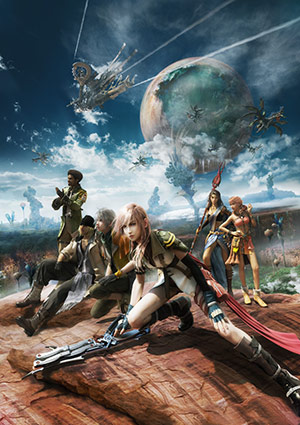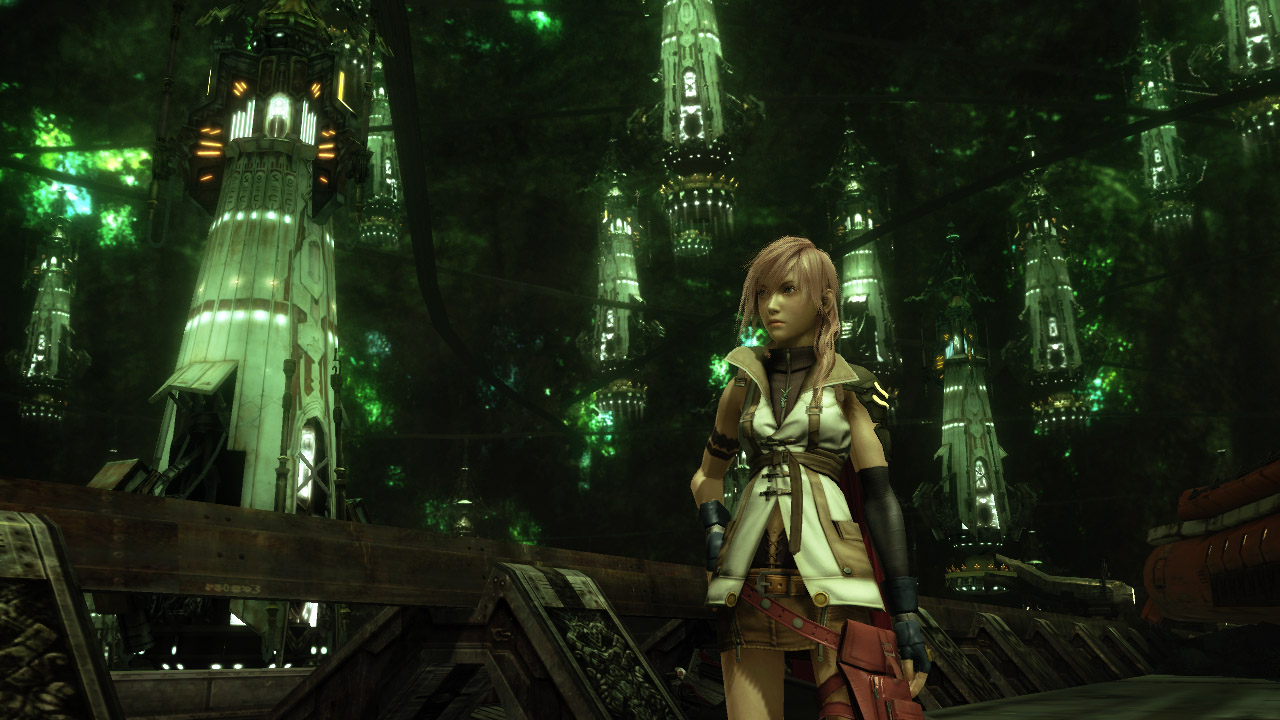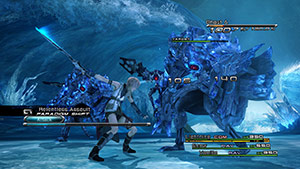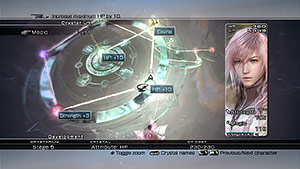
When Final Fantasy XIII was first unveiled at E3 2006, many fans breathed a sigh of relief. It had been a strange and tumultuous time for the storied franchise. The CGI movie Advent Children had simultaneously impressed and bewildered audiences with its cutting-edge animation and incomprehensible plotline. The most recent mainline entry, Final Fantasy XII, had just released in Japan and, while well received, was something of a departure from the series' traditional roots. The recently revealed Final Fantasy VII tech demo for PS3 had demonstrated the potential for a new generation of Final Fantasy, and expectations couldn't have been higher. The image of a stylish new heroine, Lightning, battling her way through a sci-fi inspired setting filled with direct callbacks to VII blew those expectations out of the water. "While the various goofball offshoots, online experiments, and intriguing departures designed by other teams have dutifully kept the series going," wrote Electronic Gaming Monthly, here referring to Final Fantasy X-2, XI, and XII respectively, "it's high time for a massively ambitious return to form."
It would be a long four years until release, with Square Enix remaining characteristically (for the time) tight-lipped about the game's development. Occasional details would come through: EGM reported on the game's dual settings of Cocoon and Pulse, and the designs of Snow and Fang were well received, but concrete information on the game itself was scarce. A playable demo was included with Japanese copies of Advent Children Complete, an extended rerelease of the 2005 film, but North American audiences had to settle for trailers that did little to sate their appetites. Nevertheless, Final Fantasy XIII did eventually release in Japan in December of 2009. By the time March of the following year rolled around, gamers across the globe finally got the chance to experience what was sure to be an RPG masterpiece. Not only was Final Fantasy XIII the fastest selling title in the series at the time, but it was widely praised by critics as well, with many outlets complimenting the game's technical prowess and bold new gameplay direction. In their review, Gametrailers.com said, "Final Fantasy XIII embraces a feeling of immediacy that ultimately serves it well...don't let its streamlined approach scare you away."
Of course, we all know how that turned out, don't we? It didn't take long for gamers and critics alike to turn on Final Fantasy XIII. Players lambasted the game's linearity, its lengthy tutorials, the simplified combat, and its dense storytelling predicated on understanding a deluge of in-game lore. While initial reviews had been positive, the critical consensus quickly turned sour, with Gametrailers eventually criticizing the game in a top ten list of "worst Final Fantasy games." "It received a great score...but the game has no defenders among the current staff." Final Fantasy XIII marked a turning point for Square Enix that would sour their reputation for years to come. But how had the former titan of the games industry allowed their flagship series to end up in such dire straits?

Motomu Toriyama is a name synonymous with the Final Fantasy XIII brand. His career in game design for Squaresoft began in 1994, working on such titles as Bahamut Lagoon and eventually as an "Event Planner" for the submarine sequence in Final Fantasy VII. However, he would later go on to direct and co-write the scenario for Final Fantasy X. His name appears in the credits of Final Fantasy X-2, Final Fantasy XII: Revenant Wings, and Dissidia Final Fantasy, but it's with Final Fantasy XIII that he truly made his mark, serving as director and scenario writer across what is now dubbed the "Lightning Saga." While it would be unfair to lay the blame for XIII's failings solely at his feet, Toriyama's candidness about the project is illuminating, to say the least.
"I felt that this trailer set the bar for the quality we were aiming to achieve, in terms of battle speed and cutscene imagery, and believed that this sentiment was shared by the rest of the team," Toriyama says, in an interview for Game Developer Magazine. Yet it soon became clear that this vision was not widely held by the rest of the development team: a lack of shared vision would haunt Final Fantasy XIII's development for years.

According to Toriyama, XIII was originally being developed for the PS2: the delayed release of Final Fantasy XII, which itself had a tumultuous development cycle, is theorized in an article by Jeremy Parish for USGamer to have influenced the decision to move XIII's development to the PlayStation 3 and Xbox 360 instead. "...After working on the game for about a year or so, we had to make the decision of which console to develop the game for," says Toriyama. "Our mission was to achieve the highest technology in game design. These two factors resulted in our decision to develop the game on the next-gen consoles instead."
Transitioning to unfamiliar hardware, particularly the infamously difficult PlayStation 3 architecture, certainly had an impact on the development team. Having to live up to the specter of the FFVII Tech Demo, which had been revealed to the public a year prior to XIII at E3 2005, also weighed heavily on Toriyama and his team, who had abandoned work on their project for a six-month period in order to complete the tech demo. But it was the graphics engine that ultimately proved to be the biggest obstacle to overcome. At the time, Square Enix was working on a proprietary engine that would be used to handle HD game development across a wide variety of platforms. Dubbed "The White Engine," and later known as "Crystal Tools," the engine was designed with the intent of supporting all of Square Enix's projects at the time. However, it quickly became apparent that Crystal Tools wasn't nearly efficient enough for the development team's needs. Having to optimize their engine around several ongoing projects took precious time and resources away from Final Fantasy XIII, which would reverberate throughout Square Enix.

When talking about the notorious 1.0 version of Final Fantasy XIV (which also used Crystal Tools as a base), Naoki Yoshida likened the developers at Square Enix to craftsmen. Square Enix had, for years, found themselves at the forefront of video game graphics technology, having set a high bar for themselves on the PS1 and PS2. Suddenly, the advent of HD game development dramatically increased the resources necessary to create these cutting-edge experiences, and these craftsmen were made to work with unfamiliar tools. Yoshida has been outspoken about Square Enix's "unhealthy obsession" with graphical quality, and his experience with revitalizing XIV into the highly successful MMORPG it is today relates back to XIII's development as well. "This may be at risk of being cut by corporate PR," Yoshida says in a documentary by Noclip, "but...a lot of the really talented programmers were pulled from different projects [to work on Crystal Tools] ...Square Enix in the PlayStation 2 generation had produced games with very high graphical quality that were very quality gaming experiences also. That it was regarded as top of the line [had caused] the corporation itself to become very arrogant, so to speak."
Working on Crystal Tools devoured years of Final Fantasy XIII's development time. While media outlets were fed tidbits of information about the Dyson Sphere-esque world of Cocoon, the outlying world of Pulse, and the mechanical gods known as fal'Cie, nobody realized that Toriyama's team was struggling to come up with a gameplay system to support the characters and lore they had envisioned during the PS2 days. It wasn't until the team was called upon to make a demo, which would be shipped with Japanese copies of Final Fantasy VII: Advent Children Complete, that there was clarity. According to Toriyama, having to create this vertical slice of gameplay for the demo solidified the team's vision and enabled them to finally start moving forward on the game's creation...a mere six months before its Japanese release date. If you've ever wondered why Final Fantasy XIII was so linear, this is likely the answer: Toriyama would later admit that the game was rushed through production following the release of the demo.

Ultimately, Final Fantasy XIII finally released to the aforementioned initial wave of high sales and enthusiasm that quickly tapered off into critical malaise. But Square had bigger fish to fry. Final Fantasy XIII had intended to serve as the jumping off point for a massive multimedia franchise, entitled Fabula Nova Crystallis (roughly translated as "a new crystal legend" or "new tale of the crystal"), which would expand across several platforms, sharing the basic mythos of Final Fantasy XIII (the concept of l'Cie and fal'Cie, the goddess Etro, and other mythological elements). Unfortunately, despite their grand ambitions, little of this would come to pass. The mobile game announced as Final Fantasy Agito XIII would be reworked into an action RPG for the PSP called Final Fantasy Type-0, which retained its connection to Fabula Nova Crystallis but abandoned the XIII name. And the most promising of the bunch, an action RPG directed by Tetsuya Nomura (of Kingdom Hearts fame) entitled Final Fantasy Versus XIII would be dramatically reworked into what is now Final Fantasy XV. While behind the scenes details on these projects are scarcer, one can easily surmise that not only did they run afoul of the Crystal Tools engine, but their attachment to Final Fantasy XIII as a whole. Jeremy Parish's article for USGamer likened the XIII brand to "box-office poison."

Square Enix did take it upon themselves to earn back the trust of their customers. They would release two sequels, Final Fantasy XIII-2 and Lightning Returns: Final Fantasy XIII, reworking the Fabula Nova Crystallis banner into the Lightning Saga as we know it today. While neither of these games lit the world on fire, they made the most of the cut assets from XIII's development, allowing Square Enix to recoup losses and experiment with more Western design sensibilities, such as the Mass Effect-inspired dialogue options in XIII-2 or the pseudo-open world of Lightning Returns. The disastrous MMORPG XIV would receive a dramatic overhaul thanks to Yoshida, emerging as A Realm Reborn and becoming one of the most popular MMORPGs in the industry. And Square Enix became much more communicative during the development of XV, providing continuous updates on the game's progress — in very similar fashion to Final Fantasy XIV's frequent "Letter from the Producer Live" video streams — under the leadership of its new director, Hajime Tabata.
Yet the mark Final Fantasy XIII left on the series is undeniable. It's a tale all too common in the AAA gaming industry: overzealous expectations, bloated development costs, and a lack of communication and foresight on the part of the developers. Final Fantasy was able to survive XIII, and perhaps it speaks to the popularity of the franchise (and the devotion of its core fans, many of whom could enjoy the game for what it was) that Square Enix was able to bounce back from such a divisive game. But as we move past the final vestiges of Fabula Nova Crystallis, one hopes that the "massively ambitious return to form" EGM spoke of all those years ago will eventually come to pass.


